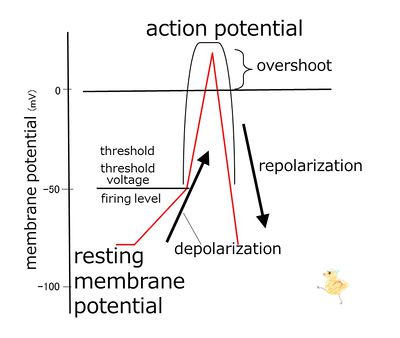「Nerv06/introduction/terms regarding membrane potential」の版間の差分
Soichi.Nakatake (トーク | 投稿記録) 編集の要約なし |
Soichi.Nakatake (トーク | 投稿記録) 編集の要約なし |
||
| 1行目: | 1行目: | ||
[[ファイル:02617en.jpg|400px|left]] | [[ファイル:02617en.jpg|400px|left]] | ||
Inside the cell membrane at rest, a negative potential is being generated. With stimulation, this negative potential decreases. This is called depolarization. When the membrane potential decreases to a certain level, an active potential, called the action potential is generated. The voltage this transaction occurs, is called the threshold, threshold voltage, or firing level.<br> | |||
<br> | |||
The characteristics of the action potential are rapid depolarization and overshoot. Overshoot means switching of the electric polarity in and outside the cell membrane, making it positive inside.<br> | |||
<br> | |||
After overshoot, the negative polarity again increases rapidly, and the action potential ends, returning to resting membrane potential. This process is called the re-polarization. | |||
{{QuizTitle}} | {{QuizTitle}} | ||
| 7行目: | 11行目: | ||
//LEVEL:2 | //LEVEL:2 | ||
//RAND | //RAND | ||
The process of the (absolute voltage of the) resting membrane potential decreasing and the neuron changing towards activation is call {~hyperpolarization.=depolarization}. | |||
神経細胞の静止膜電位(の絶対値)が減少し(静止膜電位が浅くなり)、神経細胞が興奮に向かう過程を {~過分極.=脱分極} という。 | 神経細胞の静止膜電位(の絶対値)が減少し(静止膜電位が浅くなり)、神経細胞が興奮に向かう過程を {~過分極.=脱分極} という。 | ||
//LEVEL:3 | //LEVEL:3 | ||
//RAND | //RAND | ||
The neuron cell membrane {~repolarizes.=depolarizes} when stimulated. | |||
//LEVEL:3 | //LEVEL:3 | ||
//RAND | //RAND | ||
When the membrane potential depolarizes to the firing level (threshold, threshold voltage), the action potential {=is.~is not} generated. | |||
//LEVEL:3 | //LEVEL:3 | ||
//RAND | //RAND | ||
When the membrane potential depolarizes even a small amount from the resting membrane potential, action potential would always be generated. {~true.=false} | |||
4 | |||
//LEVEL:3 | //LEVEL:3 | ||
//RAND | //RAND | ||
神経細胞が興奮するとovershootが起こり、細胞内の電気的極性が入れかわり、細胞内が {=陽性.~陰性} になる。 | 神経細胞が興奮するとovershootが起こり、細胞内の電気的極性が入れかわり、細胞内が {=陽性.~陰性} になる。 | ||
When a neuron is activated and an overshoot is generated, the electrical potential of a neuron is switched | |||
//LEVEL:2 | //LEVEL:2 | ||
2012年8月24日 (金) 08:52時点における版
Inside the cell membrane at rest, a negative potential is being generated. With stimulation, this negative potential decreases. This is called depolarization. When the membrane potential decreases to a certain level, an active potential, called the action potential is generated. The voltage this transaction occurs, is called the threshold, threshold voltage, or firing level.
The characteristics of the action potential are rapid depolarization and overshoot. Overshoot means switching of the electric polarity in and outside the cell membrane, making it positive inside.
After overshoot, the negative polarity again increases rapidly, and the action potential ends, returning to resting membrane potential. This process is called the re-polarization.
Challenge Quiz
The process of the (absolute voltage of the) resting membrane potential decreasing and the neuron changing towards activation is call hyperpolarization.depolarization .
神経細胞の静止膜電位(の絶対値)が減少し(静止膜電位が浅くなり)、神経細胞が興奮に向かう過程を 過分極.脱分極 という。
The neuron cell membrane repolarizes.depolarizes when stimulated.
When the membrane potential depolarizes to the firing level (threshold, threshold voltage), the action potential is. is not generated.
When the membrane potential depolarizes even a small amount from the resting membrane potential, action potential would always be generated. true.false
神経細胞が興奮するとovershootが起こり、細胞内の電気的極性が入れかわり、細胞内が 陽性. 陰性 になる。
overshootにひきつづき、膜電位は静止膜電位へ向けて 脱.再 分極する。
